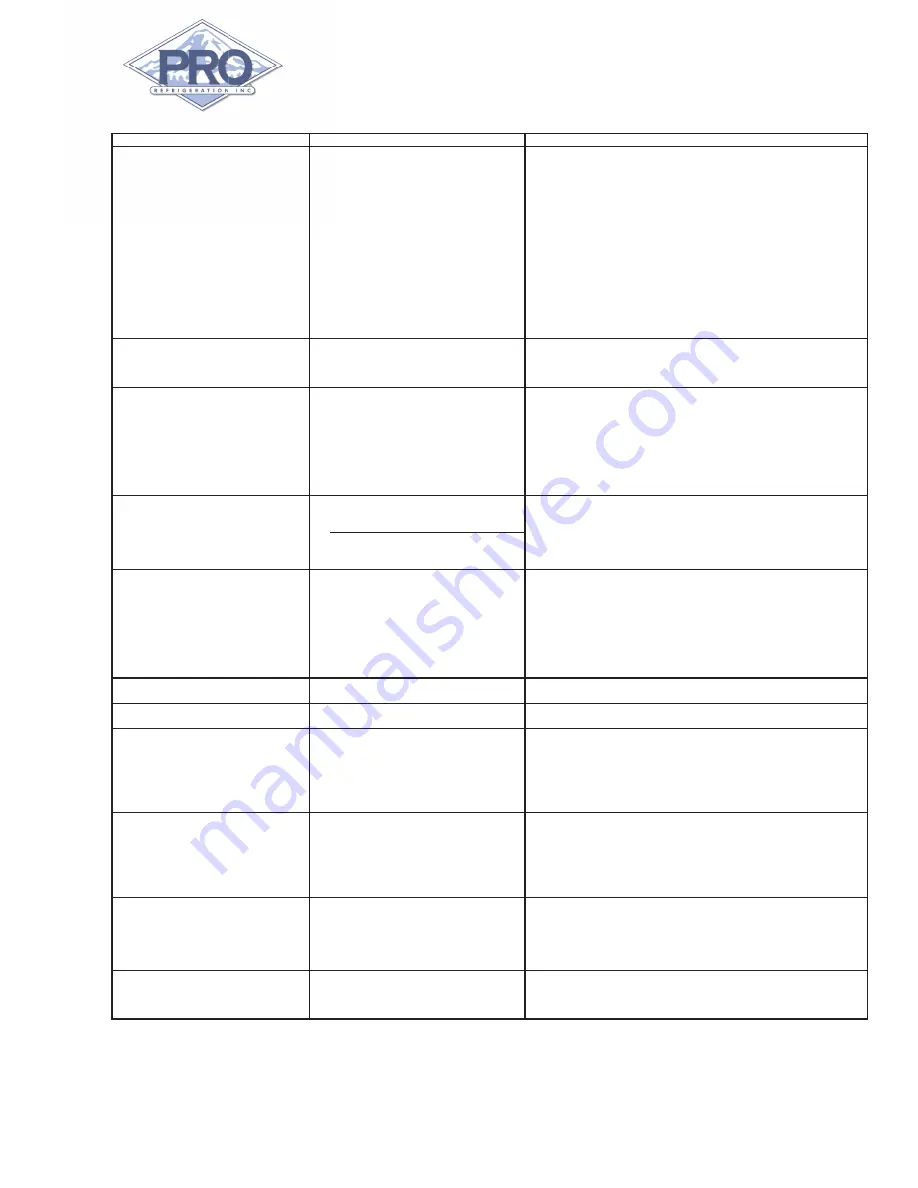
Packaged Glycol Chiller Systems |
III
PROBLEM
POSSIBLE CAUSES
CORRECTIVE STEPS
compressor will not run
A
Main Switch / Circuit Breaker Open
A
Reset Switch / Circuit Breaker
B
Fuse Blown
B
Check Electrical Circuits and Motor Windings
C
Thermal Overloads Tripped
for shorts or grounds. Investigate for possible over-
D
Defective Contactor or Coil
loading. Replace Fuse or reset Circuit Breaker after
E
System shut down by Safety Device
fault is corrected.
F
No Cooling is required
C
Reset any tripped thermal overloads, Check unit
G
Liquid Line solenoid will not open
closely when unit comes online.
H
Motor Electrical Trouble
D
Repair or replace coil
I
Loose Wiring
E
Determine Type and Cause of shut down and
J
Circulation Pump Not Running
correct before resetting.
F
Wait until Unit calls for Cooling. Check setting of
Thermostat. Check the Temperature of Glycol Solution.
G
Check for Voltage at Solenoid Coil, replace coil.
H
Check motor for opens, short circuit, or burnout.
I
Check all wire junctions, tighten loose connections.
J
Check overload relay on circulation Pump
Compressor noisy or vibrating
A
Liquid Refrigerant Flooding to Crankcase
A
Check Superheat Setting of Expansion Valve(s).
B
Worn Compressor
Check the Glycol Solution Percentage, make
certain that evaporator is not freezing up.
B
Replace Compressor
High Discharge Pressure
A
Condenser Water Supply is insufficient or
A
Adjust Water Regulating Valve, investigate ways to
temperature is too high.
increase water supply.
B
Fouled Condenser (Water)
B
clean
Fouled Cooling Tower
C
Purge out non-condensables, reclaim refrigerant
Dirty Condenser Fin or Tube Surface (Air)
and recharge with new refrigerant.
C
Non-Condensables in System
D
Remove excess refrigerant charge
D
System overcharged with Refrigerant
E
Open Valve
E
Discharge Valve Partially closed
F
Check Condenser Rating Tables
F
High Ambient Conditions
Low Discharge Pressure
A
Faulty Condenser Fan Control
A
Check Fan Controls
B
Suction Shut off partially closed
B
Open Valve
C
C
Adjust Water Regulating Valve or Water Supply
D
D
See "Low Suction Pressure" below
E
Insufficient Refrigerant Charge
E
Check for leaks, repair & recharge
F
Low Ambient Conditions
F
Check Condenser rating tables
Low Suction Pressure
A
Lack of Refrigerant
A
Check for leaks, repair, & recharge.
B
Clogged Liquid Line Filter Drier
B
Replace
C
Expansion Valve malfunction
C
Check Superheat Setting, adjust or replace.
D
Condensing Temperature too low
D
Check means of regulating Condensing Temperature
E
Compressor will not unload
E
See "Compressor will not unload" section below
F
Insufficient Flow through evaporator
F
Check circulation pump rotation and motor amperage.
G
Not enough Glycol Concentration or Glycol
Make sure Gate Valves on Evaporator inlet & outlet
Level in Tank is too Low.
are completely open.
7-5
G
Add required Glycol to System
High Suction Pressure
A
Excessive Load
A
Reduce Load or add additional cooling equipment
B
Expansion Valve malfunction
B
Check Superheat of TXV, replace if necessary
Compressor will not unload
A
Unloader mechanism defective
A
Replace mechanism
B
Faulty Thermostat or Pressure Control
B
Check settings of device, replace if necessary
Oil Alarm
A
Excessive Liquid Refrigerant in crankcase
A
Check crankcase Heater. Adjust TXV superheat.
B
Oil Failure Control defective
B
Replace
C
Worn Oil Pump
C
Replace Oil Pump.
D
Stuck reversing gear on oil pump
D
Reverse Rotation of Compressor
E
Worn Bearings
E
Replace Compressor
F
Low Oil Level
F
Check System for leaks, repair, & add Oil.
G
Pump Housing Gasket leaks
G
Replace Gasket
Motor Overload Fault, tripped Circuit
A
Low Voltage during high load conditions
A
Check for excessive voltage drop
Breaker, or Blown Fuses
B
Grounded wiring in motor or power circuit
B
Check wiring and repair fault.
C
Loose power wiring
C
Check wiring and tighten any loose connections
D
High Condensing Pressure
D
See corrective steps for "High Discharge Pressure"
E
Voltage unbalance
E
Check Power Supply. Contact Power Company. Do not
F
High Ambient at bi-metal Overload Relay
Operate until fault is corrected.
F
Provide Ventilation to Motor Controls
Compressor Thermal Switch Open
A
Operating out of design conditions
A
Add facilities to prevent system from operating out of
B
Discharge Valve Partially closed
design conditions.
C
Blown Valve Plate Gasket
B
Open
D
Power Line Fault
C
Replace Gasket
D
Check Power Supply. Contact Power Company. Do not
Operate until fault is corrected.
Low Pressure Freeze Alarm
A
Wrong Pump Rotation
A
Reverse Rotation of circulation pump (CW from motor end)
B
Evaporator Freeze Up
B
Check Glycol Percentage. Must be at least 20 F below
C
Incorrect Freeze Point setpoint
thermostat set point.
C
Adjust freeze point for application, consult factory.
Содержание CHILSTAR Series
Страница 1: ...Operations Manual...
Страница 7: ...Packaged Glycol Chiller Systems 5 3ST Series Pump Curve 5SH Series Pump Curve...
Страница 24: ...Packaged Glycol Chiller Systems V NOTES...


















